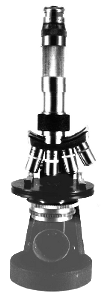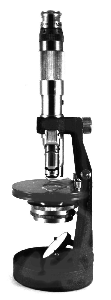An
Unusual Microscope by the name 'OTROPIC'
by Mike Dingley,
Australia
As a collector of portable / field
type microscopes I have recently acquired an unusual microscope
in which the objectives are mounted in a row on an arc-shaped
metal bar instead of being mounted on a rotating disc as is the
usual scenario. Coarse and fine focusing is operated by turning
concentric barrels on the microscope tube. In its normal position
the instrument stands 240mm high and 290mm when the drawtube is
extended.
 At the rear of the stage between the
stage clips are the words; Made in Germany Otropic Nr. 826.
Hermann Wetzer Pfronten / Bayern. This company produced the
Otropic microscope from late 1947 till 1952 or 1953 and produced
about 2,500 - 3,000 units which were mostly sent to customers in
Hong Kong and Rio de Janeiro. It appears that this was the only
microscope to be produced by the company as they normally made
other instruments.
At the rear of the stage between the
stage clips are the words; Made in Germany Otropic Nr. 826.
Hermann Wetzer Pfronten / Bayern. This company produced the
Otropic microscope from late 1947 till 1952 or 1953 and produced
about 2,500 - 3,000 units which were mostly sent to customers in
Hong Kong and Rio de Janeiro. It appears that this was the only
microscope to be produced by the company as they normally made
other instruments.
THE STAND
The limb and round base are metal coated with a crinkle (wrinkle)
finish black paint. The ferrous metal base is circular, 75mm in
diameter, 16mm thick and has a conical depression in the top
surface allowing full movement of the mirror. The limb is
attached to the base via two slot headed bolts from recessed
holes under the base. The limb is 89mm high and has a slot 17mm
wide from the top which ends 7mm from the base and gives it the
appearance of twin pillars. The limb is pivoted with trunnions at
the top of the pillar so that the tube, objectives, stage,
condenser and mirror can all be tilted.
THE MIRROR
There is a double sided plain/concave mirror 34mm in diameter
which is mounted on a swivelling yoke which in turn is fixed to a
swinging arm 40mm in length. All surfaces except the mirror are
painted black on brass.
THE CONDENSER
The condenser is nickel plated brass and is non-centerable. It
has a thread which screws into a collar which forms part of the
underside of the stage. Movement is up and down only. There is an
iris diaphragm.
THE STAGE
 The fixed stage is circular, 75mm in diameter, 7mm
thick (not including the condenser mount) and is finished in
smooth black paint over brass. The slide holders consist of two
spring metal stage clips 35mm long. Around the edge of the
circumference is a V-shaped groove to allow accessory stages to
be secured with locating screws. Under the stage slightly to the
front and left (as facing the instrument) is a lever bent at the
rear with a notch which acts as a stop to prevent the condenser
from being raised too high.
The fixed stage is circular, 75mm in diameter, 7mm
thick (not including the condenser mount) and is finished in
smooth black paint over brass. The slide holders consist of two
spring metal stage clips 35mm long. Around the edge of the
circumference is a V-shaped groove to allow accessory stages to
be secured with locating screws. Under the stage slightly to the
front and left (as facing the instrument) is a lever bent at the
rear with a notch which acts as a stop to prevent the condenser
from being raised too high.
There are two additional stages
and are attached to the existing stage by first removing the
stage clips and then placing them on top of it using pins and
screws to lock them in position. The first one is a centring
stage with its own stage clips fitted. It forms a circle, 86mm
across with a flat edge at the rear. It has a rim on the
underside 8mm deep in which a pin mounted at the front but
inside, acts as a locating pin when inserted into the existing
stage groove. At the rear, but on either side, are two screws
with knurled heads which also fit into the existing stage groove
allowing it to be centred.
The other stage is a
rectangular graduated mechanical stage. At the front are two
screw bolts with knurled heads angled towards each other which
are screwed into the V-shaped groove of the existing stage
finally to secure it in position. The slide is held flat by means
of a wide U-shaped, spring loaded wire. The x and y stages are
graduated. The x axis is numbered 0-8 in 0.5 divisions and the y
axis is numbered from 0-16 also in 0.5 divisions. Each main
division is equal to 1mm of slide movement. Both x and y axis
screws are graduated 0-50 with 1 complete turn equivalent to each
AB division or 0.5mm on the stage.
THE OBJECTIVES
The non-standard objectives are 21mm long and 12mm in diameter.
The thread is 8mm X 0,5 pitch. When viewed from the front the
objectives line up laterally (left to right) to the stage and
each objective is selected by pushing one side of the bar
laterally until the suitable objective clicks in to position
above the light path. The objective bar is curved upwards (arc
shaped) and when viewed from either end there is a female
dovetail cut on either side near the top which runs along its
length.
The objective carrier slides
through the tube with a male dovetail cut in to it. A major
drawback with this type of objective mounting is that the top of
each objective is open to dust and dirt particles.
The four objectives are marked;
1. Rau-Optic Wetzlar 78:1 n.a.
0.90
2. Rau-Optic Wetzlar 45:1 n.a. 0.85
3. Rau-Optic Wetzlar 30:1 n.a. 0.65
4. no marking 18:1 (no n.a. marking)
THE TUBE
The tube has a mechanical length of 125mm and appears to made
from nickel-plated brass and is fixed to the microscope limb
through a collar and set firmly with a knurled screw. Coarse and
fine focusing are not carried out by the conventional methods but
are controlled by the movement of concentric barrels forming the
tube of the microscope. These barrels are threaded and focusing
is achieved by rotating the knurled areas which raises or lowers
the objectives.
The coarse focusing tube is
40mm long part of which (27mm) is knurled. Each revolution of the
coarse tube is equal to about a 2mm rise in the objective. The
fine focusing tube is above the coarse focusing tube and is
tapered at its apex where it is marked with 100 graduations each
being 0.001mm. There is a draw tube which can be raised 50mm
above its normal position.
EYEPIECES
There are six eyepieces present in the case marked 5X, 8X, 10X,
12X, 15X and 20X Periplan. All eyepieces are 15mm in diameter and
are therefore smaller than the standard.
THE CASE
The case measures 270mm X 114mm X 100mm and is hinged in the
middle along the long axis so that when open both the lid and
base rest flat. It is made from wood and covered in a black
cloth. On the lid near the right hand corner is the word Otropic.
There are two metal clasps to secure the lid, however, only one
is complete. The inside is covered in red felt which shows signs
of wear and the microscope and accessories are compartmentalised.
There is a space where another accessory should be but is
missing. The total weight of the case containing all items is
2105g.
OPERATION OF THE
INSTRUMENT
The microscope is quite difficult to use for several reasons:
Firstly because the instrument is small, lightweight and has a
small diameter base the instrument is easily moved when the
focusing tubes are turned. This same problem occurs when the
objectives are selected as the bar carrying them is a tight fit
in the corresponding dovetail. The base of the instrument has to
held when focusing and selecting the various objectives.
All of the objectives are
achromatic so that the image, when focused in the centre of the
field of view is out of focus towards the periphery. With higher
magnifications this "out of focus" image gets larger
with a reduction in size of the "in focus" circle.
However, the objectives are still in good condition providing a
clear image especially when using the 5X eyepiece. The quality of
the image deteriorates when the higher power eyepieces are used
but cellular details can still be seen with reasonable clarity
especially when you consider that the instrument was not intended
as research quality.
Mike Dingley
Editor's note:
the Microscopy UK and Micscape Editors would like to thank Mike
Dingley, who is a new contributor to Micscape magazine, for
submitting this original article.
© Microscopy UK or their
contributors.
Please report any Web problems
or offer general comments to the Micscape Editor,
via the contact on current Micscape Index.
Micscape is the on-line monthly
magazine of the Microscopy UK web
site at Microscopy-UK
WIDTH=1
© Onview.net Ltd, Microscopy-UK, and all contributors 1995 onwards. All rights
reserved. Main site is at www.microscopy-uk.org.uk with full mirror at www.microscopy-uk.net.
 At the rear of the stage between the
stage clips are the words; Made in Germany Otropic Nr. 826.
Hermann Wetzer Pfronten / Bayern. This company produced the
Otropic microscope from late 1947 till 1952 or 1953 and produced
about 2,500 - 3,000 units which were mostly sent to customers in
Hong Kong and Rio de Janeiro. It appears that this was the only
microscope to be produced by the company as they normally made
other instruments.
At the rear of the stage between the
stage clips are the words; Made in Germany Otropic Nr. 826.
Hermann Wetzer Pfronten / Bayern. This company produced the
Otropic microscope from late 1947 till 1952 or 1953 and produced
about 2,500 - 3,000 units which were mostly sent to customers in
Hong Kong and Rio de Janeiro. It appears that this was the only
microscope to be produced by the company as they normally made
other instruments. The fixed stage is circular, 75mm in diameter, 7mm
thick (not including the condenser mount) and is finished in
smooth black paint over brass. The slide holders consist of two
spring metal stage clips 35mm long. Around the edge of the
circumference is a V-shaped groove to allow accessory stages to
be secured with locating screws. Under the stage slightly to the
front and left (as facing the instrument) is a lever bent at the
rear with a notch which acts as a stop to prevent the condenser
from being raised too high.
The fixed stage is circular, 75mm in diameter, 7mm
thick (not including the condenser mount) and is finished in
smooth black paint over brass. The slide holders consist of two
spring metal stage clips 35mm long. Around the edge of the
circumference is a V-shaped groove to allow accessory stages to
be secured with locating screws. Under the stage slightly to the
front and left (as facing the instrument) is a lever bent at the
rear with a notch which acts as a stop to prevent the condenser
from being raised too high.